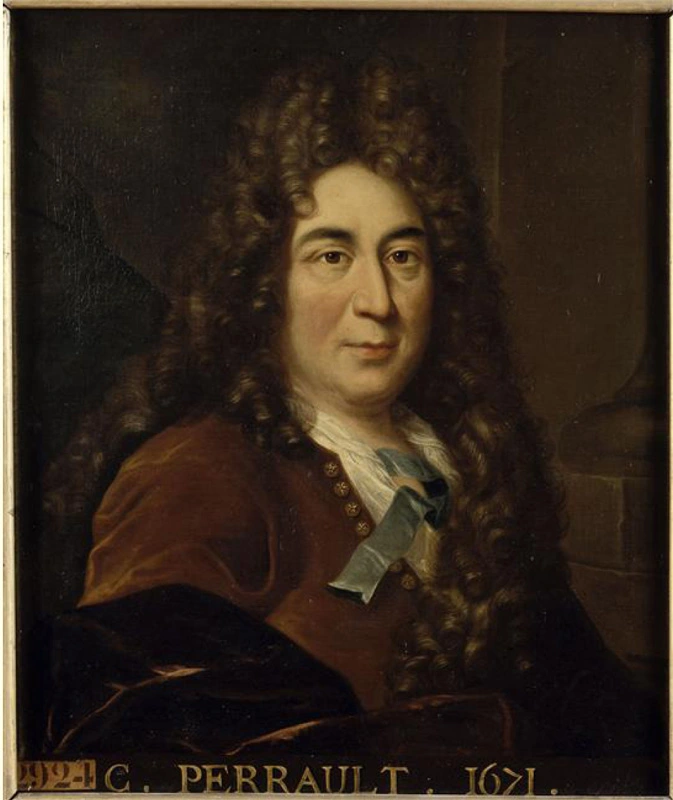His inaugural address was greeted with such
enthusiasm that he suggested that the inauguration of future members should be a public function. His suggestion was adopted, and these addresses became the most famous feature of the
Academy’s proceedings, as they still are today. This was not Perrault’s only service to the Academy – he successfully proposed a motion to the effect that future elections should
be effected by secret ballot, inventing and providing (at his own expense) a ballot box, which, although he doesn’t describe it, was probably the model for those in use in clubs and societies
today.
The originality of his views did not always endear him to his brother Academicians, the ‘Immortals’. His poem ‘Le Siècle de Louis XIV’ gave rise to one of the most
famous and protracted literary quarrels of the era. In praising the writers of his own day Perrault dared to disparage some of the authors of the ancient classics. The poet and critic Nicolas
Boileau worked himself into a furious opposition, hurling insults at Perrault. The somewhat more subtle Racine pretended to think that the poem was a work of ingenious irony. Most of the
Academicians joined the fray. There is no doubt that Perrault’s position was untenable, but he defended himself with good humour and wit. As a result, the violence of Boileau’s
reaction, and his obvious desire to display the extent of his learning, simply made him look absurd. Perrault states the Modernist case in Le Parallèle des Anciens et des Modernes, published
in four volumes in 1688–96. He clearly took more pride in this dull and now almost forgotten work than in the incomparable stories that have made him famous.

Portrait of Charles Perrault (1628-1703)
Contrôleur général des Bâtiments du roi, membre de l’Académie française Paris, palais de l’Institut
© RMN / Droits réservés
After 20 years in Colbert’s service, the sun was beginning to set on Perrault’s fortunes. His brother Pierre, the Chief Commissioner of Taxes, had a dispute with Colbert and resigned
in disgrace. Then Perrault became engaged to a young woman of whom nothing is known except that Colbert opposed the match. (At this time Colbert’s own influence with the king was waning, and
this was having an adverse effect on his mood.) It was in Perrault’s nature, that although he was a courtier, he could be relied on to consider the wishes of nobody except himself and his
future wife and he refused to break the engagement. He slipped quietly from Colbert’s service in 1683, at the age of 55.
However, before he left the court, he succeeded in frustrating an initiative that would have closed the Tuileries Gardens to the people of Paris. Colbert wanted to have them reserved for the use
of the king, but Perrault persuaded him to come for a walk with him there one day so that he could show him the people taking the air and playing with their children. He had the gardeners declare
that these privileges were never abused, and drove home his point by declaring that the gardens were ‘so spacious that there was room for all [the king’s] children to walk
there’.
In the nineteenth century the literary critic Charles Sainte-Beuve proposed that this service to the children of Paris should be commemorated by a statue of Perrault in the Tuileries Gardens.
The statue was never erected, and to this day Paris, although plentifully endowed with statues and portraits of the great men of France, has none to show that she appreciates the genius of
Perrault. There is, in fact, no statue of him in existence; indeed, the only painting of him is a rather dubious one that hangs in an obscure corner of the palace at Versailles.
The end of Perrault’s official career coincided with the beginning of his period of greatest literary activity. In 1686 he published a long narrative poem, ‘Saint Paulin Evesque de
Nole’, along with a ‘Christian Epistle on Penitence’ and an ‘Ode to the Newly-converted’, which he dedicated to the bishop and theologian Jacques-Bénigne
Bossuet. Le Parallèle des Anciens et des Modernes appeared between 1688 and 1696. In 1693 he brought out his Cabinet des Beaux Arts, beautifully illustrated with engravings and
including a poem that even Boileau deigned to admire. In 1694 he published his ‘Apologie des Femmes’. He wrote two comedies: ‘L’Oublieux’ and ‘Les
Fontanges’. These weren’t printed until 1868 and ultimately contributed little to his reputation. Between 1691 and 1697 he wrote the Histoires ou Contes de Temps Passé,
perhaps better known as Les Contes de ma Mère l’Oye, published in English as Tales of Mother Goose, and the Contes en Vers. Towards the end of his life he was
working on Eloges des Homines Illustres du Siècle de Louis XIV, the first volume of which was published in 1696, and the second in 1700, illustrated by 102 engravings, including one
of Perrault himself by Gerard Edelinck, and another of his brother Claude. These biographies are a valuable contribution to the history of the reign of the Sun King. This list of Perrault’s
writings is not exhaustive, but includes the best of his work.
Perrault died in 1703 at the age of 75, admired and mourned by all who knew him. He was clever, honest, courteous and witty, and carried out his duty to his family, his employer, his friends and
the general public.
1 comment